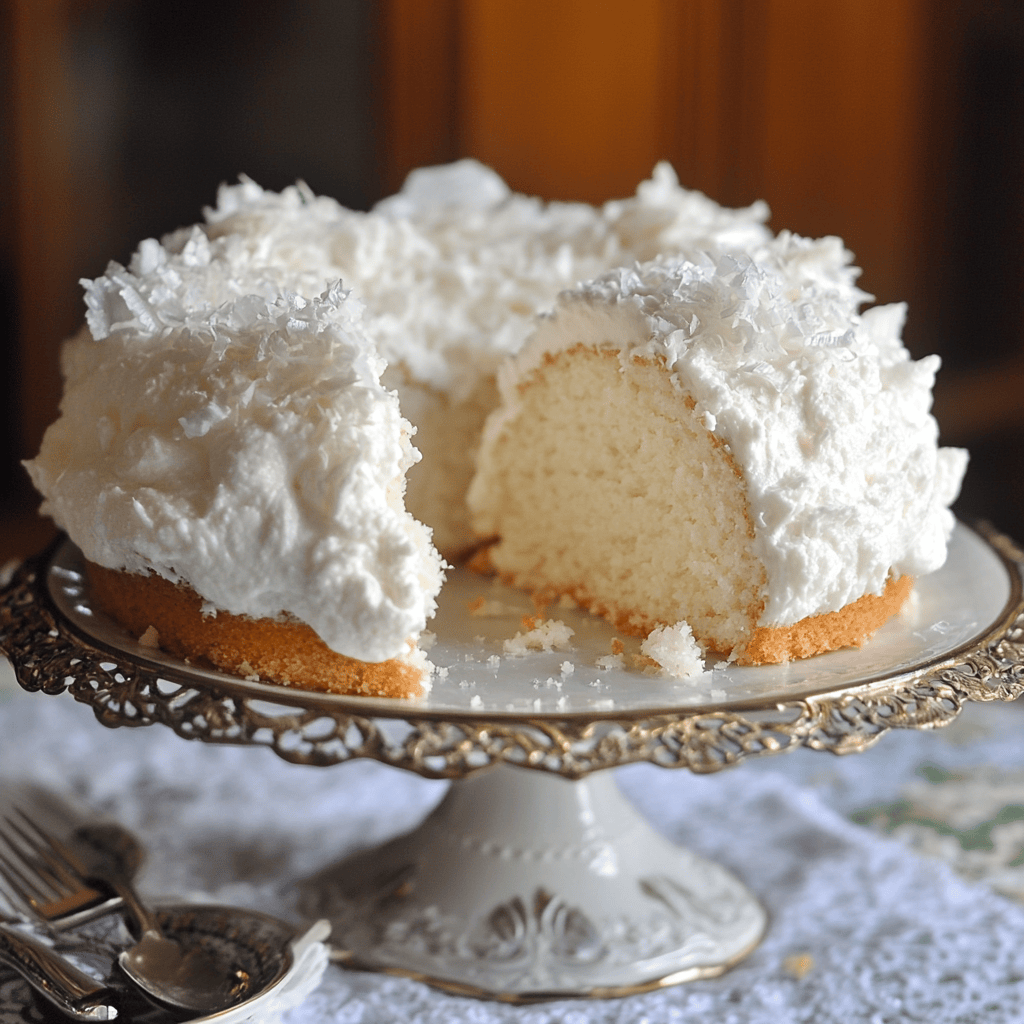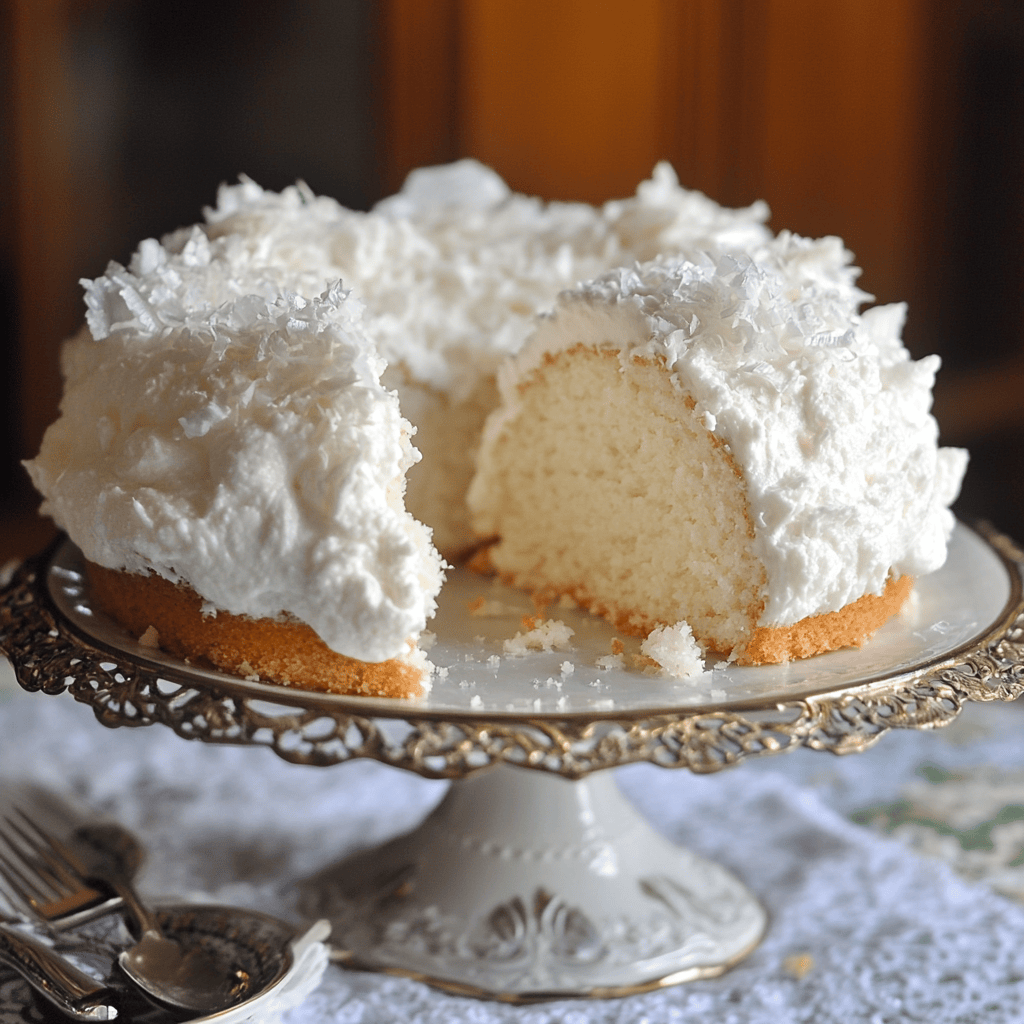Coconut Cloud Cake is a dreamy, light, and elegant dessert that combines the fluffy texture of sponge cake or chiffon cake with the rich, tropical essence of coconut. Known for its airy crumb and creamy frosting, this cake is often described as a slice of heaven, making it a favorite for celebrations, spring gatherings, or whenever a touch of indulgence is needed. With its snow-white appearance, subtle sweetness, and cloud-like softness, Coconut Cloud Cake is a beautiful centerpiece that delights both the eyes and the palate.
The History of Coconut Cloud Cake
The origins of Coconut Cloud Cake are tied to the broader evolution of coconut desserts in Western cuisine, particularly in the United States during the early to mid-20th century. Canned coconut milk and shredded coconut became household staples in America in the 1920s and ’30s, when tropical imports were more readily available. Cakes like coconut layer cake and coconut cream pie rose to popularity, especially in Southern baking traditions, where coconut was prized for its unique flavor and luxurious texture. The idea of a “cloud cake” emerged from chiffon cakes, which were invented in the late 1940s by Harry Baker, a Los Angeles insurance salesman turned baker. Chiffon cakes are known for their exceptionally light and airy texture, achieved by beating egg whites separately and folding them into the batter. The fusion of this light cake style with the rich flavor of coconut led to the Coconut Cloud Cake—a dessert that looks delicate, tastes decadent, and feels like eating a sweet, tropical cloud. Over the decades, it has evolved to include variations such as coconut whipped cream, cream cheese or mascarpone frostings, and even vegan versions, all while preserving its iconic lightness and signature coconut profile.
Ingredients Breakdown
- Cake Base: Often made with cake flour for a tender crumb, sugar for sweetness, baking powder or baking soda for lift, salt to balance the flavors, and a neutral oil or butter for moisture. Egg yolks and whipped egg whites (or a mix of whole eggs and whipped whites) contribute to the soft, airy texture.
- Coconut Flavor Elements: Shredded sweetened or unsweetened coconut adds texture and flavor, while coconut milk or coconut extract intensifies the tropical essence. Coconut cream may be used for a richer cake.
- Frosting: Common choices include whipped cream frosting, coconut cream frosting, or cream cheese-based frosting. Powdered sugar adds sweetness, and vanilla or coconut extract enhances flavor.
- Filling (optional): Some versions include a coconut pastry cream or a layer of coconut-flavored whipped cream in the center of the cake.
- Topping: Toasted or untoasted coconut flakes are sprinkled generously over the top and sides for texture and presentation.
Step-by-Step Recipe
- Preheat the Oven: Set the oven to 325°F (165°C). Grease and flour two 8- or 9-inch round cake pans or line with parchment paper for easy release.
- Prepare the Dry Ingredients: In a medium bowl, sift together 2 1/2 cups cake flour, 2 teaspoons baking powder, and 1/2 teaspoon salt.
- Mix the Wet Ingredients: In a large mixing bowl, beat together 1 cup sugar, 1/2 cup vegetable oil (or melted butter), and 4 egg yolks until thick and pale. Add 1 cup coconut milk, 1 teaspoon vanilla extract, and 1/2 teaspoon coconut extract. Mix until smooth.
- Combine Wet and Dry: Gradually add the dry ingredients to the wet mixture, mixing just until incorporated. Do not overmix.
- Whip Egg Whites: In a separate clean bowl, beat 4 egg whites with 1/4 teaspoon cream of tartar until soft peaks form. Gradually add 1/4 cup sugar and beat until stiff peaks form.
- Fold Egg Whites into Batter: Gently fold the whipped egg whites into the batter in batches, being careful not to deflate the mixture.
- Bake the Cake: Divide the batter evenly between the prepared pans and smooth the tops. Bake for 25–30 minutes or until a toothpick inserted into the center comes out clean. Let cool completely on a wire rack.
- Prepare the Frosting: In a chilled bowl, whip 2 cups heavy cream with 1/2 cup powdered sugar and 1/2 teaspoon coconut extract until stiff peaks form. Alternatively, make a cream cheese frosting by beating 8 ounces cream cheese, 1/2 cup butter, 3–4 cups powdered sugar, and flavoring until smooth.
- Assemble the Cake: Place one cake layer on a serving plate, spread a generous layer of frosting, and top with the second cake layer. Frost the top and sides completely.
- Decorate: Press shredded or flaked coconut onto the frosting, covering the cake entirely. Garnish with toasted coconut or white chocolate shavings for extra elegance.
- Chill and Serve: Refrigerate for at least 1 hour before slicing to allow the cake to set. Serve chilled or at room temperature.
Tips for the Perfect Coconut Cloud Cake
Use room-temperature ingredients to ensure even mixing and better rise. Sift your dry ingredients to keep the crumb light and airy. When folding in the egg whites, use a gentle motion to preserve airiness—this step is key to the “cloud” texture. Do not overbake the cake; it should be moist and soft. Toasting the coconut topping can add a layer of nutty flavor, but keep a close eye on it as it browns quickly. For a more stable whipped cream frosting, add a tablespoon of cornstarch or instant pudding mix. If making ahead, store the frosted cake in the fridge and allow it to come slightly to room temperature before serving for the best texture.
Variations and Customizations
Use coconut cream instead of coconut milk for a richer flavor and denser texture. For a gluten-free version, substitute cake flour with a gluten-free baking blend and ensure other ingredients are certified gluten-free. Make it vegan by using egg substitutes (like aquafaba for whipped whites), plant-based milk and cream, and vegan butter or coconut oil. Add pineapple chunks or a pineapple jam layer for a piña colada twist. Incorporate lemon zest or lime zest for a citrusy brightness. Use a coconut meringue topping for a showstopping alternative to traditional frosting. Add a splash of rum to the cake batter or frosting for a more decadent, tropical flair.
Health Considerations and Nutritional Value
Coconut Cloud Cake is a moderately indulgent dessert with a balance of carbohydrates, fats, and sugars. Using coconut milk adds some healthy fats known as medium-chain triglycerides (MCTs), which are thought to offer certain metabolic benefits. However, the cake also contains sugar and saturated fats from the cream and coconut, so portion control is recommended. Using whole-grain flour or a sugar substitute can lighten the nutritional impact slightly. Choosing a whipped cream-based frosting over buttercream can reduce overall calories. For those with dietary restrictions, it’s easy to adapt for dairy-free, gluten-free, or egg-free needs. Keep in mind that coconut, although nutritious, is calorie-dense, so a small slice can go a long way in satisfying sweet cravings.
FAQ
Q: Can I make Coconut Cloud Cake ahead of time?
A: Yes, the cake can be baked a day ahead, and frosting can be applied just before serving. Refrigerate the cake to keep it fresh.
Q: How should I store leftovers?
A: Store the cake covered in the refrigerator for up to 4 days. Let it sit out for 10–15 minutes before serving for the best texture.
Q: Can I freeze this cake?
A: You can freeze unfrosted cake layers wrapped tightly in plastic and foil. Thaw completely before frosting and serving.
Q: What’s the best type of coconut to use?
A: Use unsweetened shredded coconut for a more natural taste, or sweetened if you prefer a sweeter finish. Flaked coconut works well for decoration.
Q: Can I use boxed cake mix as a shortcut?
A: Yes, a white or yellow boxed cake mix can be used with coconut milk substituted for water and added coconut extract for flavor.
Q: Is this cake suitable for people with nut allergies?
A: Coconut is classified as a fruit by the FDA, but some with nut allergies react to it. Always check with individuals and use nut-free kitchen practices.
Q: How do I make it lighter in calories?
A: Use reduced-fat coconut milk, light whipped topping, and cut down on sugar in both the cake and frosting. A single-layer version with less frosting is also an option.

Coconut Cloud Cake Recipe
Ingredients
Method
- Preheat the oven to 350°F (175°C) and prepare two 9-inch round cake pans by greasing and lining them as needed.
- In a bowl, whisk together the flour, baking powder, and salt. In a separate large bowl, beat the softened butter with the sugar until light and fluffy. Add the eggs one at a time, mixing well after each addition. Stir in the vanilla and coconut extracts. Gradually add the dry ingredients to the wet mixture, alternating with the coconut milk, beginning and ending with the dry ingredients.
- Divide the batter evenly between the prepared pans and bake for 25 to 30 minutes, or until a toothpick inserted into the center comes out clean. Allow the cakes to cool completely on a wire rack.
- To make the frosting, beat the cream cheese with the powdered sugar until smooth and creamy. In another bowl, whip the heavy cream until stiff peaks form, then gently fold it into the cream cheese mixture until fully combined.
- Assemble the cake by layering and frosting both cake layers. Press the shredded coconut all over the top and sides of the cake to create a soft, cloud-like appearance.
- Refrigerate the finished cake for at least 1 hour before serving for best texture and flavor.
Notes
Toast the shredded coconut to enhance its aroma and add a richer, nutty taste.
